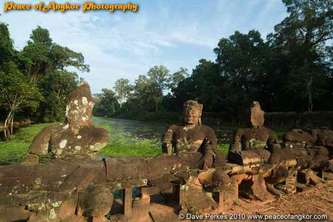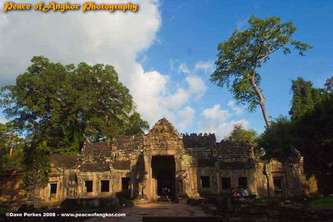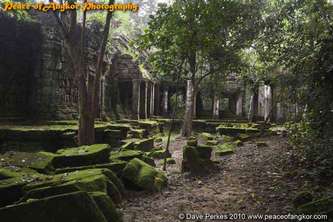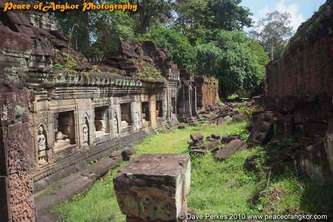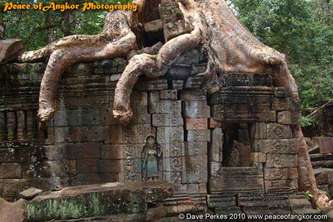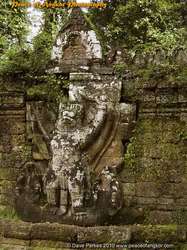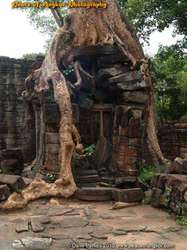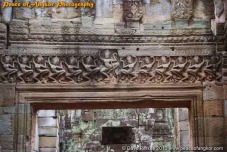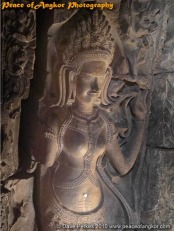PEACE OF ANGKOR PHOTOGRAPHY
PREAH KHAN - Temple of the Sacred Sword
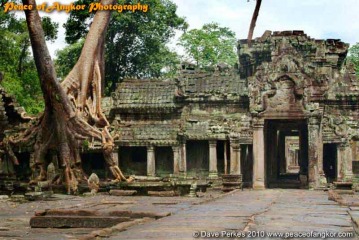
The East Gopura of Preah Khan
Built in the 12th Century Preah Khan was dedicated to the father of king Jayavarman VII; so is sometimes known as Father Temple.
The temple was a city in its own right. It was a place of festivals with over 1000 Apsaras or celestial dancers performing 18 times per year Preah Khan is the second largest temple enclosure in Angkor. Preah Khan had an army of 80,000 to service and maintain it; which must have been an amazing sight!
Within its square kilometre enclosure lies a temple complex which is almost as atmospheric as Ta Prohm. It is very much better preserved; though still has some eerie root formations; the most impressive being shown here.
With many narrow passages and secret chambers; Preah Kahn is a delight to explore.
The temple was a city in its own right. It was a place of festivals with over 1000 Apsaras or celestial dancers performing 18 times per year Preah Khan is the second largest temple enclosure in Angkor. Preah Khan had an army of 80,000 to service and maintain it; which must have been an amazing sight!
Within its square kilometre enclosure lies a temple complex which is almost as atmospheric as Ta Prohm. It is very much better preserved; though still has some eerie root formations; the most impressive being shown here.
With many narrow passages and secret chambers; Preah Kahn is a delight to explore.
You are in Angkor Temples - Angkor Wat - Angkor Thom - Ta Prohm - Preah Khan - Eastern Temples
The Design of Preah Khan
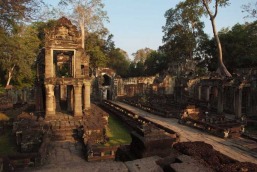
The NE quadrant Preah Khan
Preah Khan was built in the 12th Century on the site of the battle where Jayavarman VII's army had a victory over the invading Chams in 1191. The name Temple of The Sacred Sword derives from Nagara Jayasri (holy city of victory)
The temple has outer walls with an 800 x 700 metre moat surrounding the main temple. The laterite wall of Preah Khan has 72, five metre high Garudas holding Nagas.
To the East are the Halls of The Dancers and a unique round columned building that looks as though it came from Ancient Greece or the Roman Empire. The desighn is thought to be of Javanese origin.
The view here shows this eastern section from the high Royal Crematorium near sunset.
The temple has outer walls with an 800 x 700 metre moat surrounding the main temple. The laterite wall of Preah Khan has 72, five metre high Garudas holding Nagas.
To the East are the Halls of The Dancers and a unique round columned building that looks as though it came from Ancient Greece or the Roman Empire. The desighn is thought to be of Javanese origin.
The view here shows this eastern section from the high Royal Crematorium near sunset.
After its decline and abandonment. Preah Khan was rediscovered and restored in the late 19th century.
During The Khmer Rouge era it was used as an army base.The very observant visitor, will see the damage done by armoured vehicles to the paving and walls at some of the entrances.
During The Khmer Rouge era it was used as an army base.The very observant visitor, will see the damage done by armoured vehicles to the paving and walls at some of the entrances.
The Baray and Preah Neak Poan
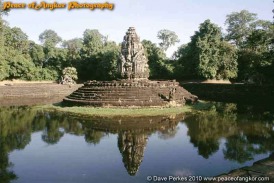
Preah Neak Poan
To the east of Preah Khan lies the 3 km long Jayatataka Baray (reservoir) which has the Preah Neak Poan temple at its centre Neak Poan is a fascinating complex of interconnected pools with an island shrine at its centre .This unique temple named after entwined serpents; was originally in the centre of the reservoir adjoining Preah Khan.
It was dedicated to the Buddha and modified by Jayavarman VII and re-dedicated to Lokeshvara. It has a set of four square basins, surrounding a larger pool with a central shrine. Four fountain heads are in the forms of a lion, horse, elephant and man.
It was dedicated to the Buddha and modified by Jayavarman VII and re-dedicated to Lokeshvara. It has a set of four square basins, surrounding a larger pool with a central shrine. Four fountain heads are in the forms of a lion, horse, elephant and man.

